Water Problems in Delhi in India
VerifiedAdded on 2023/06/09
|9
|2094
|425
AI Summary
Delhi, India's capital, is facing a major problem of water scarcity. Dumping of industrial solid wastes in water bodies by big industries and factories pollutes fresh water resources. The government has taken measures to control water pollution and conducted awareness campaigns. Water scarcity in Delhi is affecting the health of residents.
Contribute Materials
Your contribution can guide someone’s learning journey. Share your
documents today.
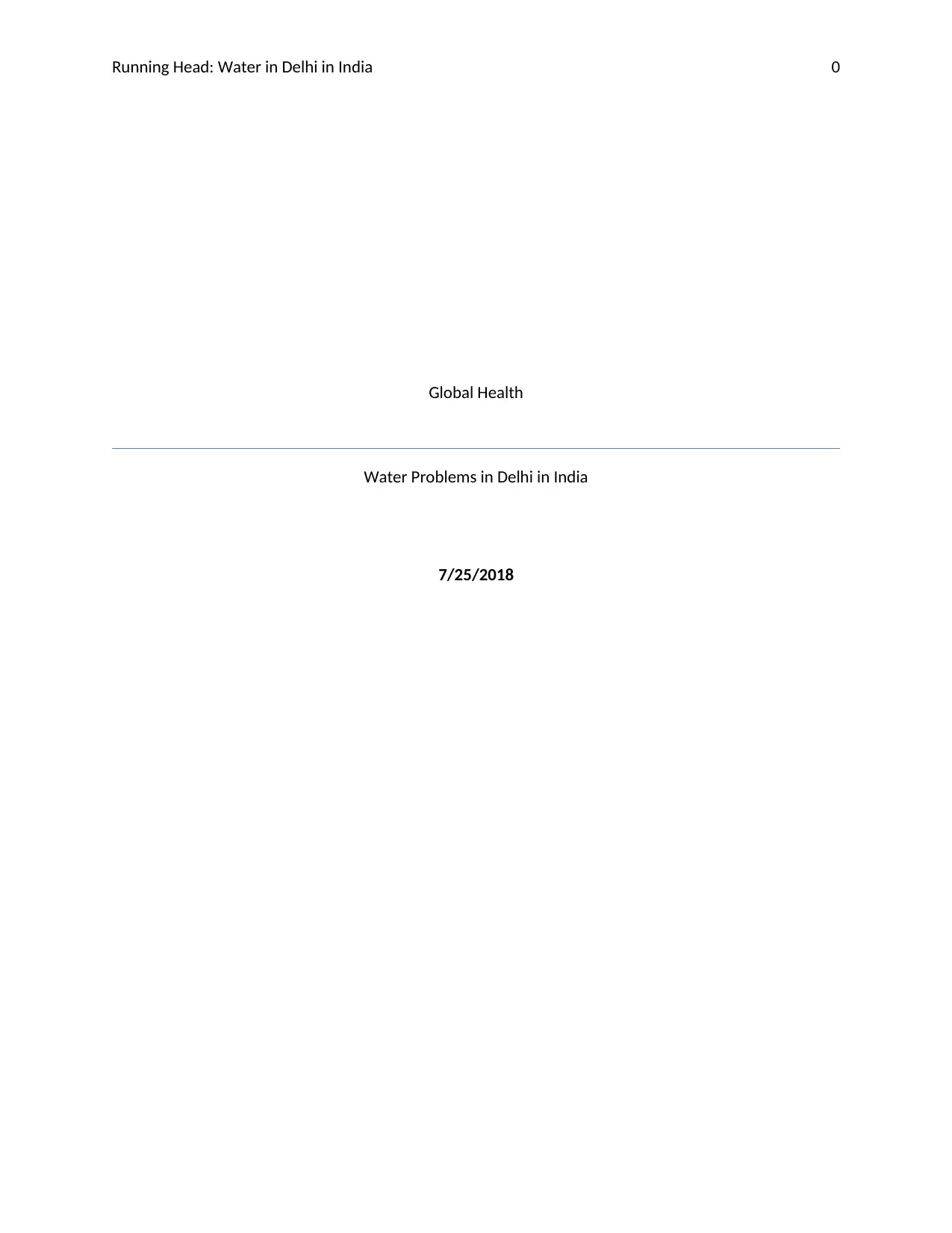
Running Head: Water in Delhi in India 0
Global Health
Water Problems in Delhi in India
7/25/2018
Global Health
Water Problems in Delhi in India
7/25/2018
Secure Best Marks with AI Grader
Need help grading? Try our AI Grader for instant feedback on your assignments.
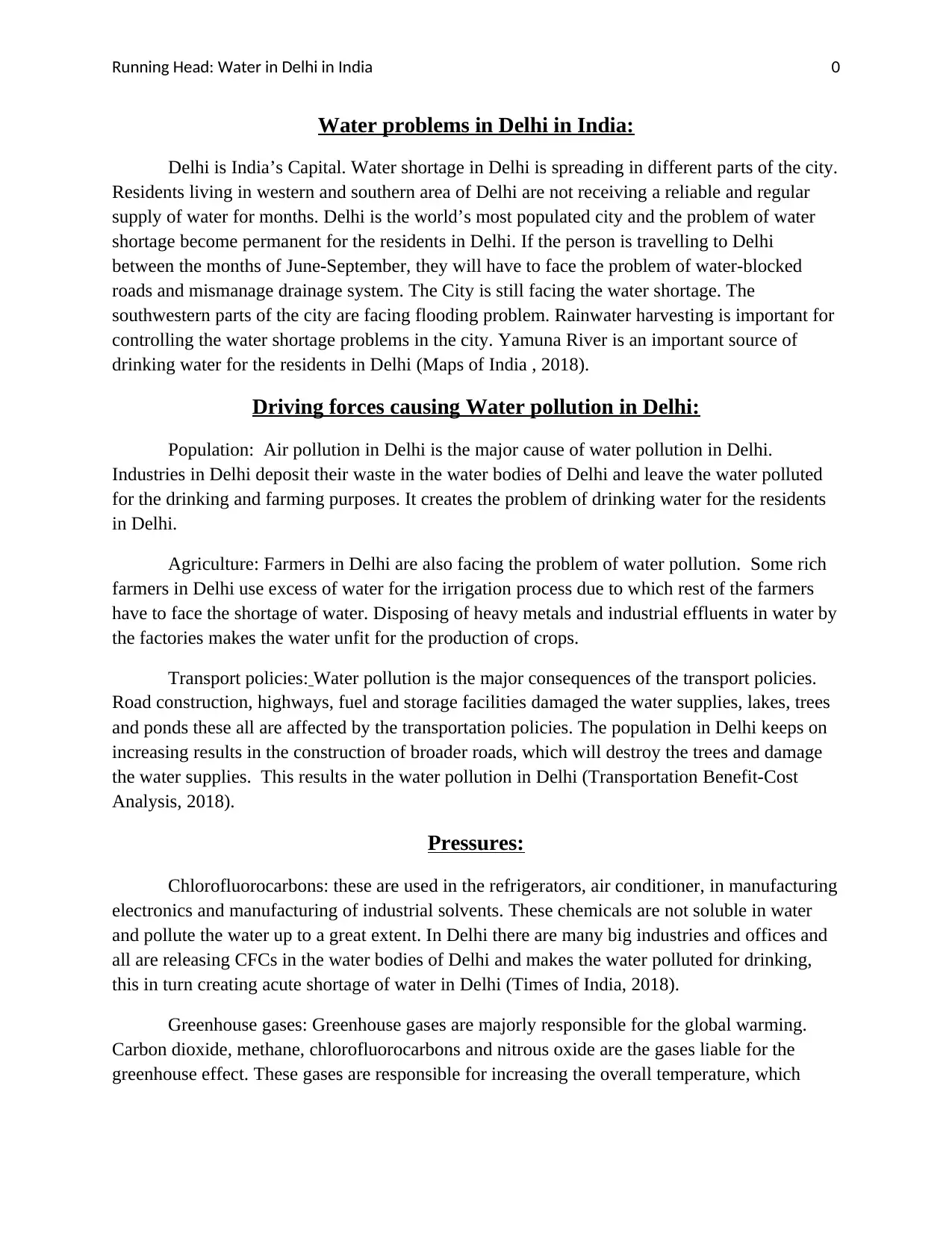
Running Head: Water in Delhi in India 0
Water problems in Delhi in India:
Delhi is India’s Capital. Water shortage in Delhi is spreading in different parts of the city.
Residents living in western and southern area of Delhi are not receiving a reliable and regular
supply of water for months. Delhi is the world’s most populated city and the problem of water
shortage become permanent for the residents in Delhi. If the person is travelling to Delhi
between the months of June-September, they will have to face the problem of water-blocked
roads and mismanage drainage system. The City is still facing the water shortage. The
southwestern parts of the city are facing flooding problem. Rainwater harvesting is important for
controlling the water shortage problems in the city. Yamuna River is an important source of
drinking water for the residents in Delhi (Maps of India , 2018).
Driving forces causing Water pollution in Delhi:
Population: Air pollution in Delhi is the major cause of water pollution in Delhi.
Industries in Delhi deposit their waste in the water bodies of Delhi and leave the water polluted
for the drinking and farming purposes. It creates the problem of drinking water for the residents
in Delhi.
Agriculture: Farmers in Delhi are also facing the problem of water pollution. Some rich
farmers in Delhi use excess of water for the irrigation process due to which rest of the farmers
have to face the shortage of water. Disposing of heavy metals and industrial effluents in water by
the factories makes the water unfit for the production of crops.
Transport policies: Water pollution is the major consequences of the transport policies.
Road construction, highways, fuel and storage facilities damaged the water supplies, lakes, trees
and ponds these all are affected by the transportation policies. The population in Delhi keeps on
increasing results in the construction of broader roads, which will destroy the trees and damage
the water supplies. This results in the water pollution in Delhi (Transportation Benefit-Cost
Analysis, 2018).
Pressures:
Chlorofluorocarbons: these are used in the refrigerators, air conditioner, in manufacturing
electronics and manufacturing of industrial solvents. These chemicals are not soluble in water
and pollute the water up to a great extent. In Delhi there are many big industries and offices and
all are releasing CFCs in the water bodies of Delhi and makes the water polluted for drinking,
this in turn creating acute shortage of water in Delhi (Times of India, 2018).
Greenhouse gases: Greenhouse gases are majorly responsible for the global warming.
Carbon dioxide, methane, chlorofluorocarbons and nitrous oxide are the gases liable for the
greenhouse effect. These gases are responsible for increasing the overall temperature, which
Water problems in Delhi in India:
Delhi is India’s Capital. Water shortage in Delhi is spreading in different parts of the city.
Residents living in western and southern area of Delhi are not receiving a reliable and regular
supply of water for months. Delhi is the world’s most populated city and the problem of water
shortage become permanent for the residents in Delhi. If the person is travelling to Delhi
between the months of June-September, they will have to face the problem of water-blocked
roads and mismanage drainage system. The City is still facing the water shortage. The
southwestern parts of the city are facing flooding problem. Rainwater harvesting is important for
controlling the water shortage problems in the city. Yamuna River is an important source of
drinking water for the residents in Delhi (Maps of India , 2018).
Driving forces causing Water pollution in Delhi:
Population: Air pollution in Delhi is the major cause of water pollution in Delhi.
Industries in Delhi deposit their waste in the water bodies of Delhi and leave the water polluted
for the drinking and farming purposes. It creates the problem of drinking water for the residents
in Delhi.
Agriculture: Farmers in Delhi are also facing the problem of water pollution. Some rich
farmers in Delhi use excess of water for the irrigation process due to which rest of the farmers
have to face the shortage of water. Disposing of heavy metals and industrial effluents in water by
the factories makes the water unfit for the production of crops.
Transport policies: Water pollution is the major consequences of the transport policies.
Road construction, highways, fuel and storage facilities damaged the water supplies, lakes, trees
and ponds these all are affected by the transportation policies. The population in Delhi keeps on
increasing results in the construction of broader roads, which will destroy the trees and damage
the water supplies. This results in the water pollution in Delhi (Transportation Benefit-Cost
Analysis, 2018).
Pressures:
Chlorofluorocarbons: these are used in the refrigerators, air conditioner, in manufacturing
electronics and manufacturing of industrial solvents. These chemicals are not soluble in water
and pollute the water up to a great extent. In Delhi there are many big industries and offices and
all are releasing CFCs in the water bodies of Delhi and makes the water polluted for drinking,
this in turn creating acute shortage of water in Delhi (Times of India, 2018).
Greenhouse gases: Greenhouse gases are majorly responsible for the global warming.
Carbon dioxide, methane, chlorofluorocarbons and nitrous oxide are the gases liable for the
greenhouse effect. These gases are responsible for increasing the overall temperature, which
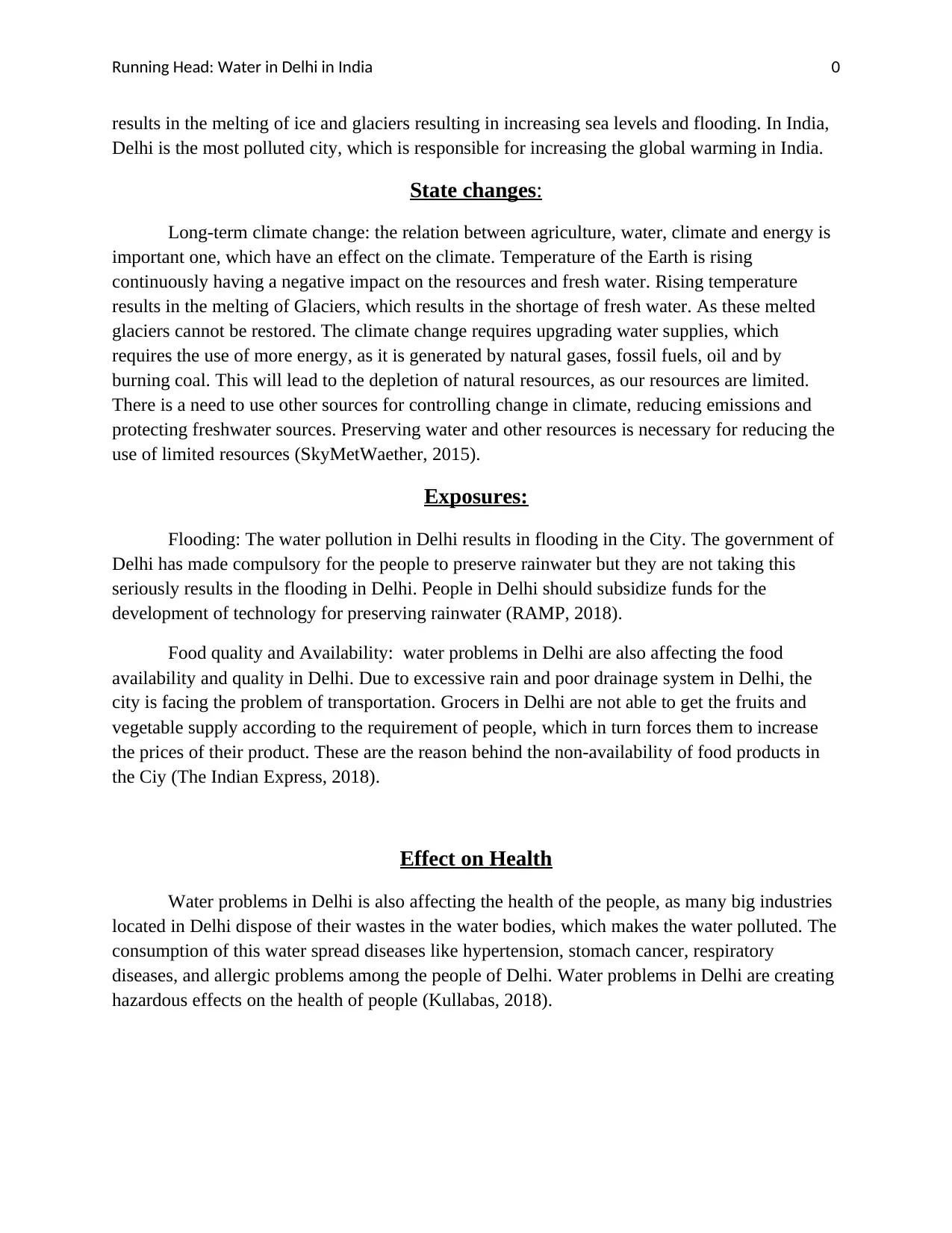
Running Head: Water in Delhi in India 0
results in the melting of ice and glaciers resulting in increasing sea levels and flooding. In India,
Delhi is the most polluted city, which is responsible for increasing the global warming in India.
State changes:
Long-term climate change: the relation between agriculture, water, climate and energy is
important one, which have an effect on the climate. Temperature of the Earth is rising
continuously having a negative impact on the resources and fresh water. Rising temperature
results in the melting of Glaciers, which results in the shortage of fresh water. As these melted
glaciers cannot be restored. The climate change requires upgrading water supplies, which
requires the use of more energy, as it is generated by natural gases, fossil fuels, oil and by
burning coal. This will lead to the depletion of natural resources, as our resources are limited.
There is a need to use other sources for controlling change in climate, reducing emissions and
protecting freshwater sources. Preserving water and other resources is necessary for reducing the
use of limited resources (SkyMetWaether, 2015).
Exposures:
Flooding: The water pollution in Delhi results in flooding in the City. The government of
Delhi has made compulsory for the people to preserve rainwater but they are not taking this
seriously results in the flooding in Delhi. People in Delhi should subsidize funds for the
development of technology for preserving rainwater (RAMP, 2018).
Food quality and Availability: water problems in Delhi are also affecting the food
availability and quality in Delhi. Due to excessive rain and poor drainage system in Delhi, the
city is facing the problem of transportation. Grocers in Delhi are not able to get the fruits and
vegetable supply according to the requirement of people, which in turn forces them to increase
the prices of their product. These are the reason behind the non-availability of food products in
the Ciy (The Indian Express, 2018).
Effect on Health
Water problems in Delhi is also affecting the health of the people, as many big industries
located in Delhi dispose of their wastes in the water bodies, which makes the water polluted. The
consumption of this water spread diseases like hypertension, stomach cancer, respiratory
diseases, and allergic problems among the people of Delhi. Water problems in Delhi are creating
hazardous effects on the health of people (Kullabas, 2018).
results in the melting of ice and glaciers resulting in increasing sea levels and flooding. In India,
Delhi is the most polluted city, which is responsible for increasing the global warming in India.
State changes:
Long-term climate change: the relation between agriculture, water, climate and energy is
important one, which have an effect on the climate. Temperature of the Earth is rising
continuously having a negative impact on the resources and fresh water. Rising temperature
results in the melting of Glaciers, which results in the shortage of fresh water. As these melted
glaciers cannot be restored. The climate change requires upgrading water supplies, which
requires the use of more energy, as it is generated by natural gases, fossil fuels, oil and by
burning coal. This will lead to the depletion of natural resources, as our resources are limited.
There is a need to use other sources for controlling change in climate, reducing emissions and
protecting freshwater sources. Preserving water and other resources is necessary for reducing the
use of limited resources (SkyMetWaether, 2015).
Exposures:
Flooding: The water pollution in Delhi results in flooding in the City. The government of
Delhi has made compulsory for the people to preserve rainwater but they are not taking this
seriously results in the flooding in Delhi. People in Delhi should subsidize funds for the
development of technology for preserving rainwater (RAMP, 2018).
Food quality and Availability: water problems in Delhi are also affecting the food
availability and quality in Delhi. Due to excessive rain and poor drainage system in Delhi, the
city is facing the problem of transportation. Grocers in Delhi are not able to get the fruits and
vegetable supply according to the requirement of people, which in turn forces them to increase
the prices of their product. These are the reason behind the non-availability of food products in
the Ciy (The Indian Express, 2018).
Effect on Health
Water problems in Delhi is also affecting the health of the people, as many big industries
located in Delhi dispose of their wastes in the water bodies, which makes the water polluted. The
consumption of this water spread diseases like hypertension, stomach cancer, respiratory
diseases, and allergic problems among the people of Delhi. Water problems in Delhi are creating
hazardous effects on the health of people (Kullabas, 2018).
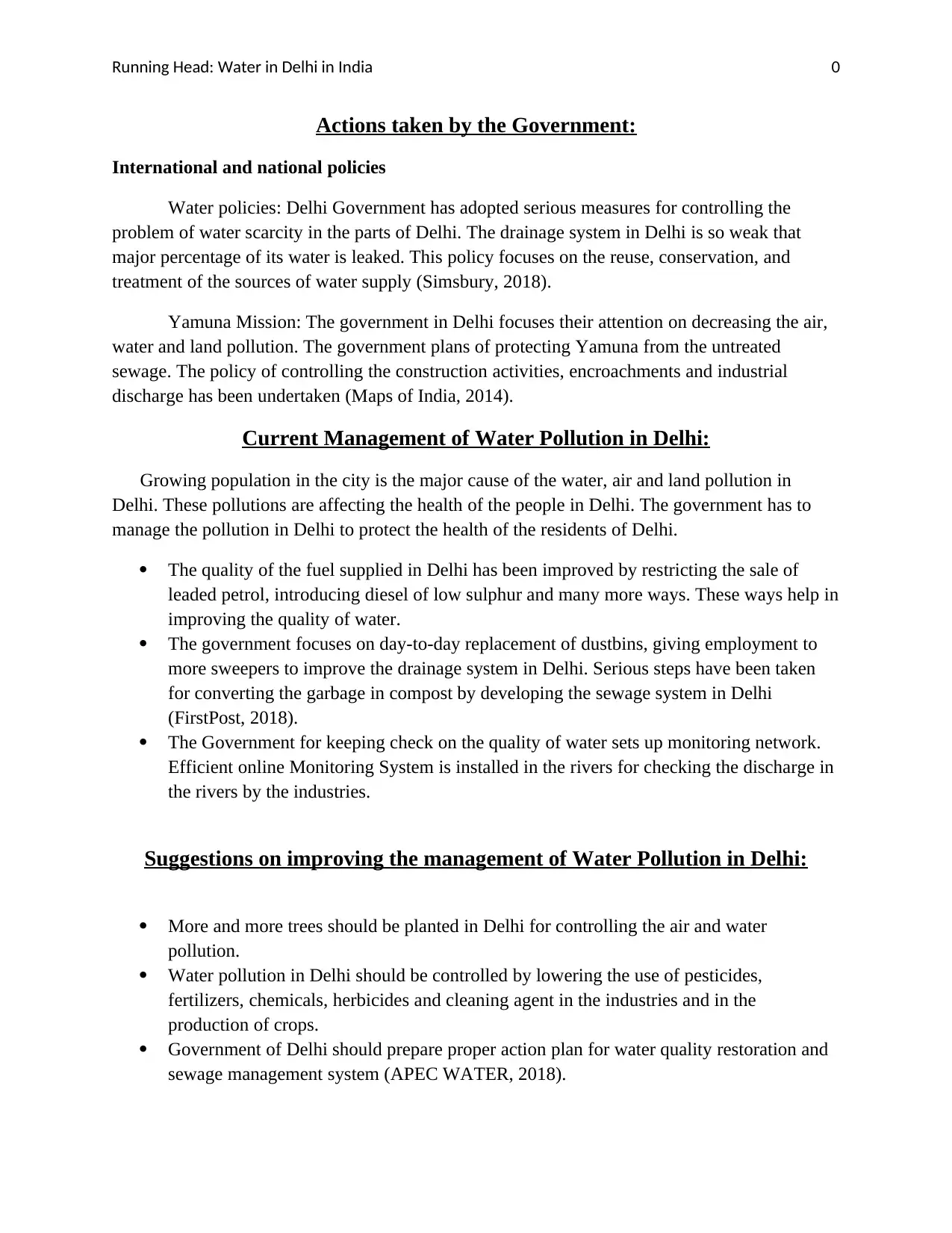
Running Head: Water in Delhi in India 0
Actions taken by the Government:
International and national policies
Water policies: Delhi Government has adopted serious measures for controlling the
problem of water scarcity in the parts of Delhi. The drainage system in Delhi is so weak that
major percentage of its water is leaked. This policy focuses on the reuse, conservation, and
treatment of the sources of water supply (Simsbury, 2018).
Yamuna Mission: The government in Delhi focuses their attention on decreasing the air,
water and land pollution. The government plans of protecting Yamuna from the untreated
sewage. The policy of controlling the construction activities, encroachments and industrial
discharge has been undertaken (Maps of India, 2014).
Current Management of Water Pollution in Delhi:
Growing population in the city is the major cause of the water, air and land pollution in
Delhi. These pollutions are affecting the health of the people in Delhi. The government has to
manage the pollution in Delhi to protect the health of the residents of Delhi.
The quality of the fuel supplied in Delhi has been improved by restricting the sale of
leaded petrol, introducing diesel of low sulphur and many more ways. These ways help in
improving the quality of water.
The government focuses on day-to-day replacement of dustbins, giving employment to
more sweepers to improve the drainage system in Delhi. Serious steps have been taken
for converting the garbage in compost by developing the sewage system in Delhi
(FirstPost, 2018).
The Government for keeping check on the quality of water sets up monitoring network.
Efficient online Monitoring System is installed in the rivers for checking the discharge in
the rivers by the industries.
Suggestions on improving the management of Water Pollution in Delhi:
More and more trees should be planted in Delhi for controlling the air and water
pollution.
Water pollution in Delhi should be controlled by lowering the use of pesticides,
fertilizers, chemicals, herbicides and cleaning agent in the industries and in the
production of crops.
Government of Delhi should prepare proper action plan for water quality restoration and
sewage management system (APEC WATER, 2018).
Actions taken by the Government:
International and national policies
Water policies: Delhi Government has adopted serious measures for controlling the
problem of water scarcity in the parts of Delhi. The drainage system in Delhi is so weak that
major percentage of its water is leaked. This policy focuses on the reuse, conservation, and
treatment of the sources of water supply (Simsbury, 2018).
Yamuna Mission: The government in Delhi focuses their attention on decreasing the air,
water and land pollution. The government plans of protecting Yamuna from the untreated
sewage. The policy of controlling the construction activities, encroachments and industrial
discharge has been undertaken (Maps of India, 2014).
Current Management of Water Pollution in Delhi:
Growing population in the city is the major cause of the water, air and land pollution in
Delhi. These pollutions are affecting the health of the people in Delhi. The government has to
manage the pollution in Delhi to protect the health of the residents of Delhi.
The quality of the fuel supplied in Delhi has been improved by restricting the sale of
leaded petrol, introducing diesel of low sulphur and many more ways. These ways help in
improving the quality of water.
The government focuses on day-to-day replacement of dustbins, giving employment to
more sweepers to improve the drainage system in Delhi. Serious steps have been taken
for converting the garbage in compost by developing the sewage system in Delhi
(FirstPost, 2018).
The Government for keeping check on the quality of water sets up monitoring network.
Efficient online Monitoring System is installed in the rivers for checking the discharge in
the rivers by the industries.
Suggestions on improving the management of Water Pollution in Delhi:
More and more trees should be planted in Delhi for controlling the air and water
pollution.
Water pollution in Delhi should be controlled by lowering the use of pesticides,
fertilizers, chemicals, herbicides and cleaning agent in the industries and in the
production of crops.
Government of Delhi should prepare proper action plan for water quality restoration and
sewage management system (APEC WATER, 2018).
Secure Best Marks with AI Grader
Need help grading? Try our AI Grader for instant feedback on your assignments.
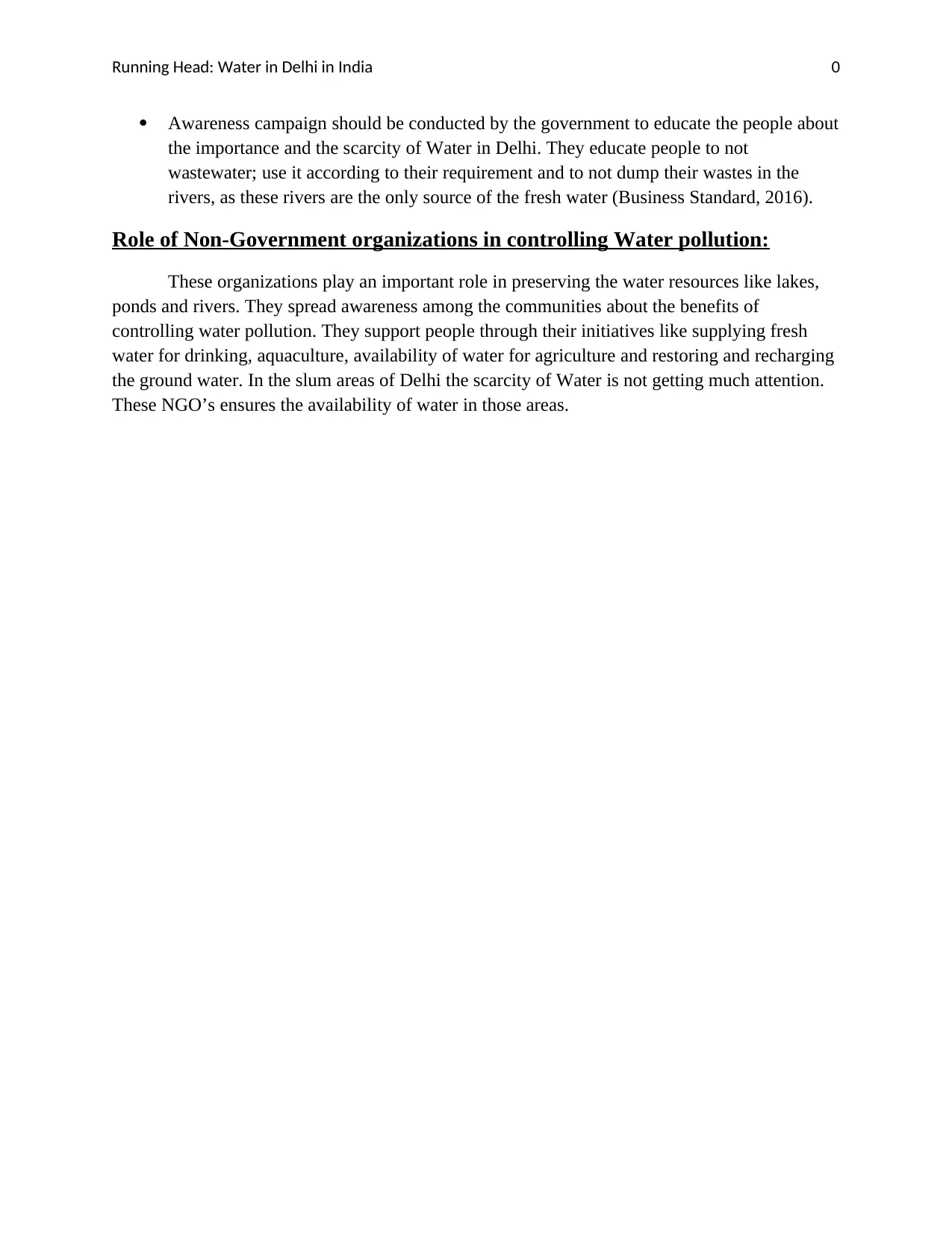
Running Head: Water in Delhi in India 0
Awareness campaign should be conducted by the government to educate the people about
the importance and the scarcity of Water in Delhi. They educate people to not
wastewater; use it according to their requirement and to not dump their wastes in the
rivers, as these rivers are the only source of the fresh water (Business Standard, 2016).
Role of Non-Government organizations in controlling Water pollution:
These organizations play an important role in preserving the water resources like lakes,
ponds and rivers. They spread awareness among the communities about the benefits of
controlling water pollution. They support people through their initiatives like supplying fresh
water for drinking, aquaculture, availability of water for agriculture and restoring and recharging
the ground water. In the slum areas of Delhi the scarcity of Water is not getting much attention.
These NGO’s ensures the availability of water in those areas.
Awareness campaign should be conducted by the government to educate the people about
the importance and the scarcity of Water in Delhi. They educate people to not
wastewater; use it according to their requirement and to not dump their wastes in the
rivers, as these rivers are the only source of the fresh water (Business Standard, 2016).
Role of Non-Government organizations in controlling Water pollution:
These organizations play an important role in preserving the water resources like lakes,
ponds and rivers. They spread awareness among the communities about the benefits of
controlling water pollution. They support people through their initiatives like supplying fresh
water for drinking, aquaculture, availability of water for agriculture and restoring and recharging
the ground water. In the slum areas of Delhi the scarcity of Water is not getting much attention.
These NGO’s ensures the availability of water in those areas.
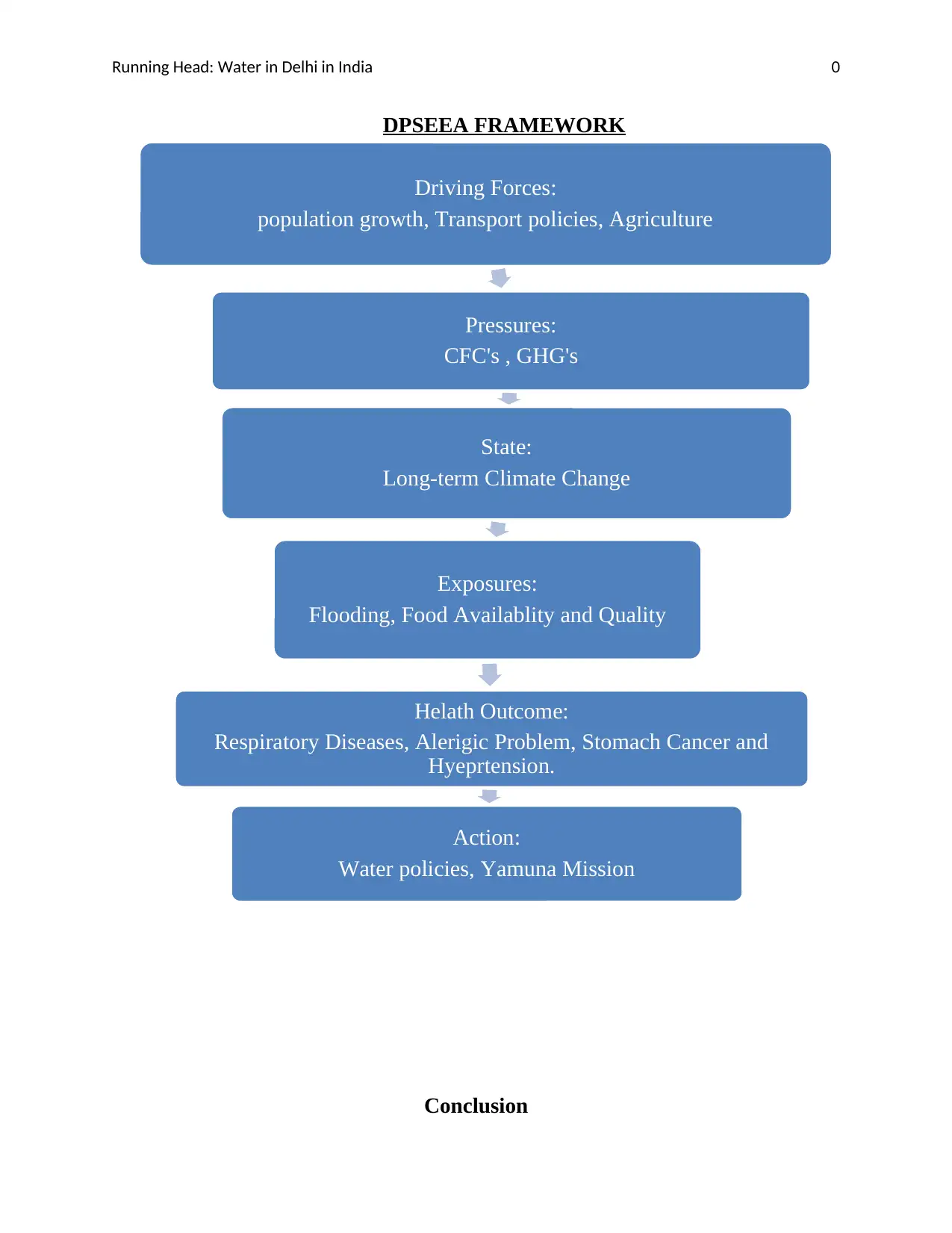
Running Head: Water in Delhi in India 0
DPSEEA FRAMEWORK
Conclusion
Driving Forces:
population growth, Transport policies, Agriculture
Pressures:
CFC's , GHG's
State:
Long-term Climate Change
Exposures:
Flooding, Food Availablity and Quality
Helath Outcome:
Respiratory Diseases, Alerigic Problem, Stomach Cancer and
Hyeprtension.
Action:
Water policies, Yamuna Mission
DPSEEA FRAMEWORK
Conclusion
Driving Forces:
population growth, Transport policies, Agriculture
Pressures:
CFC's , GHG's
State:
Long-term Climate Change
Exposures:
Flooding, Food Availablity and Quality
Helath Outcome:
Respiratory Diseases, Alerigic Problem, Stomach Cancer and
Hyeprtension.
Action:
Water policies, Yamuna Mission
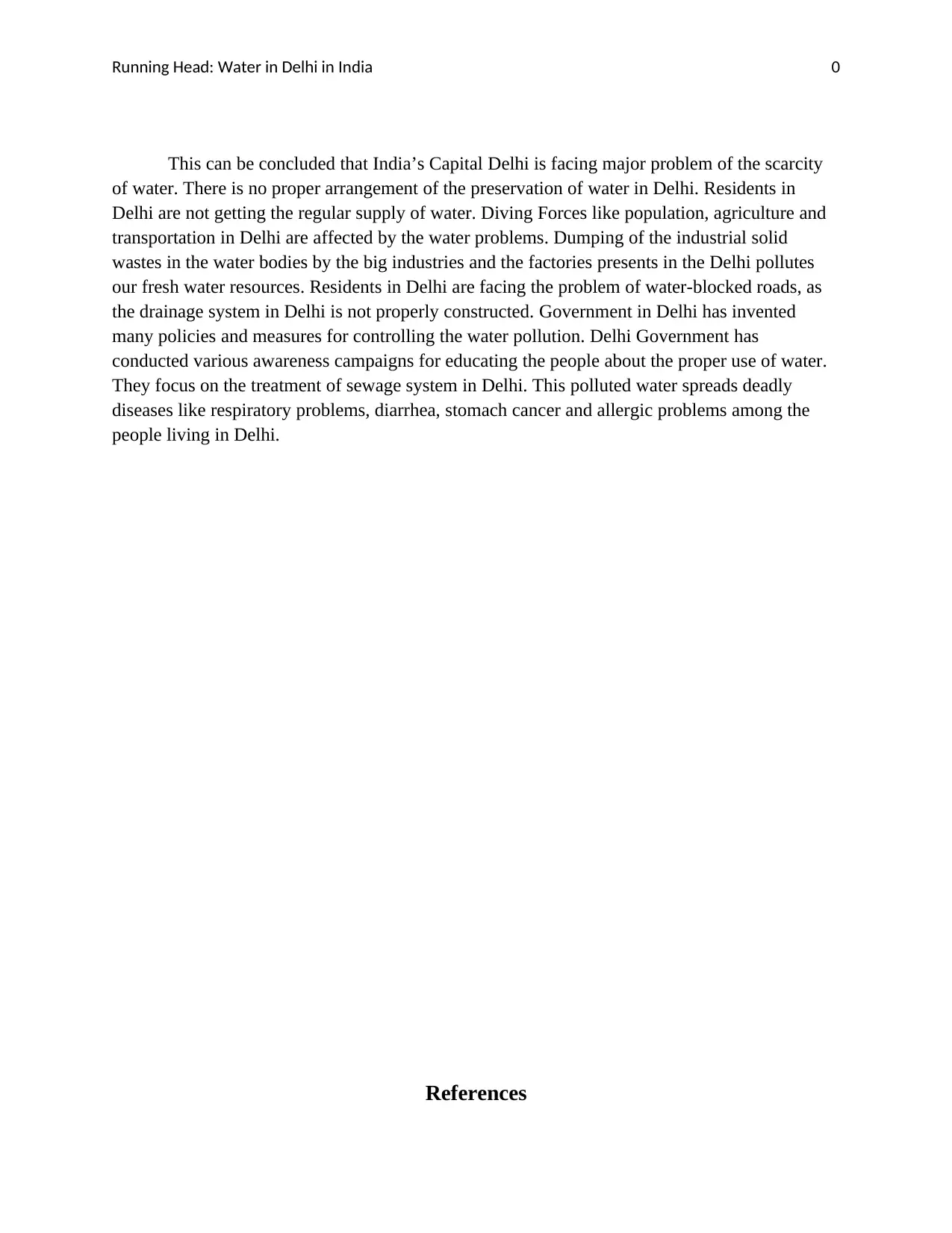
Running Head: Water in Delhi in India 0
This can be concluded that India’s Capital Delhi is facing major problem of the scarcity
of water. There is no proper arrangement of the preservation of water in Delhi. Residents in
Delhi are not getting the regular supply of water. Diving Forces like population, agriculture and
transportation in Delhi are affected by the water problems. Dumping of the industrial solid
wastes in the water bodies by the big industries and the factories presents in the Delhi pollutes
our fresh water resources. Residents in Delhi are facing the problem of water-blocked roads, as
the drainage system in Delhi is not properly constructed. Government in Delhi has invented
many policies and measures for controlling the water pollution. Delhi Government has
conducted various awareness campaigns for educating the people about the proper use of water.
They focus on the treatment of sewage system in Delhi. This polluted water spreads deadly
diseases like respiratory problems, diarrhea, stomach cancer and allergic problems among the
people living in Delhi.
References
This can be concluded that India’s Capital Delhi is facing major problem of the scarcity
of water. There is no proper arrangement of the preservation of water in Delhi. Residents in
Delhi are not getting the regular supply of water. Diving Forces like population, agriculture and
transportation in Delhi are affected by the water problems. Dumping of the industrial solid
wastes in the water bodies by the big industries and the factories presents in the Delhi pollutes
our fresh water resources. Residents in Delhi are facing the problem of water-blocked roads, as
the drainage system in Delhi is not properly constructed. Government in Delhi has invented
many policies and measures for controlling the water pollution. Delhi Government has
conducted various awareness campaigns for educating the people about the proper use of water.
They focus on the treatment of sewage system in Delhi. This polluted water spreads deadly
diseases like respiratory problems, diarrhea, stomach cancer and allergic problems among the
people living in Delhi.
References
Paraphrase This Document
Need a fresh take? Get an instant paraphrase of this document with our AI Paraphraser
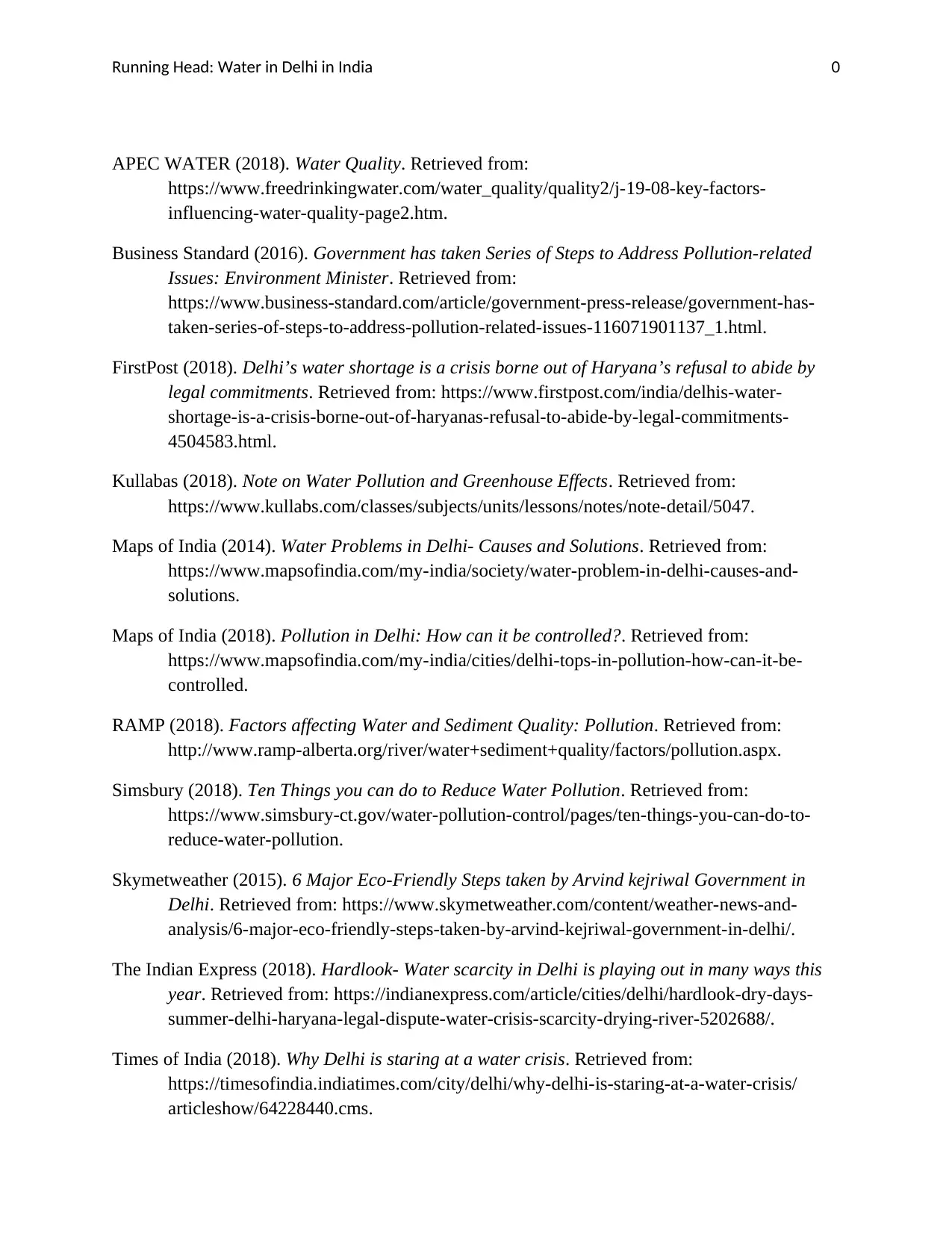
Running Head: Water in Delhi in India 0
APEC WATER (2018). Water Quality. Retrieved from:
https://www.freedrinkingwater.com/water_quality/quality2/j-19-08-key-factors-
influencing-water-quality-page2.htm.
Business Standard (2016). Government has taken Series of Steps to Address Pollution-related
Issues: Environment Minister. Retrieved from:
https://www.business-standard.com/article/government-press-release/government-has-
taken-series-of-steps-to-address-pollution-related-issues-116071901137_1.html.
FirstPost (2018). Delhi’s water shortage is a crisis borne out of Haryana’s refusal to abide by
legal commitments. Retrieved from: https://www.firstpost.com/india/delhis-water-
shortage-is-a-crisis-borne-out-of-haryanas-refusal-to-abide-by-legal-commitments-
4504583.html.
Kullabas (2018). Note on Water Pollution and Greenhouse Effects. Retrieved from:
https://www.kullabs.com/classes/subjects/units/lessons/notes/note-detail/5047.
Maps of India (2014). Water Problems in Delhi- Causes and Solutions. Retrieved from:
https://www.mapsofindia.com/my-india/society/water-problem-in-delhi-causes-and-
solutions.
Maps of India (2018). Pollution in Delhi: How can it be controlled?. Retrieved from:
https://www.mapsofindia.com/my-india/cities/delhi-tops-in-pollution-how-can-it-be-
controlled.
RAMP (2018). Factors affecting Water and Sediment Quality: Pollution. Retrieved from:
http://www.ramp-alberta.org/river/water+sediment+quality/factors/pollution.aspx.
Simsbury (2018). Ten Things you can do to Reduce Water Pollution. Retrieved from:
https://www.simsbury-ct.gov/water-pollution-control/pages/ten-things-you-can-do-to-
reduce-water-pollution.
Skymetweather (2015). 6 Major Eco-Friendly Steps taken by Arvind kejriwal Government in
Delhi. Retrieved from: https://www.skymetweather.com/content/weather-news-and-
analysis/6-major-eco-friendly-steps-taken-by-arvind-kejriwal-government-in-delhi/.
The Indian Express (2018). Hardlook- Water scarcity in Delhi is playing out in many ways this
year. Retrieved from: https://indianexpress.com/article/cities/delhi/hardlook-dry-days-
summer-delhi-haryana-legal-dispute-water-crisis-scarcity-drying-river-5202688/.
Times of India (2018). Why Delhi is staring at a water crisis. Retrieved from:
https://timesofindia.indiatimes.com/city/delhi/why-delhi-is-staring-at-a-water-crisis/
articleshow/64228440.cms.
APEC WATER (2018). Water Quality. Retrieved from:
https://www.freedrinkingwater.com/water_quality/quality2/j-19-08-key-factors-
influencing-water-quality-page2.htm.
Business Standard (2016). Government has taken Series of Steps to Address Pollution-related
Issues: Environment Minister. Retrieved from:
https://www.business-standard.com/article/government-press-release/government-has-
taken-series-of-steps-to-address-pollution-related-issues-116071901137_1.html.
FirstPost (2018). Delhi’s water shortage is a crisis borne out of Haryana’s refusal to abide by
legal commitments. Retrieved from: https://www.firstpost.com/india/delhis-water-
shortage-is-a-crisis-borne-out-of-haryanas-refusal-to-abide-by-legal-commitments-
4504583.html.
Kullabas (2018). Note on Water Pollution and Greenhouse Effects. Retrieved from:
https://www.kullabs.com/classes/subjects/units/lessons/notes/note-detail/5047.
Maps of India (2014). Water Problems in Delhi- Causes and Solutions. Retrieved from:
https://www.mapsofindia.com/my-india/society/water-problem-in-delhi-causes-and-
solutions.
Maps of India (2018). Pollution in Delhi: How can it be controlled?. Retrieved from:
https://www.mapsofindia.com/my-india/cities/delhi-tops-in-pollution-how-can-it-be-
controlled.
RAMP (2018). Factors affecting Water and Sediment Quality: Pollution. Retrieved from:
http://www.ramp-alberta.org/river/water+sediment+quality/factors/pollution.aspx.
Simsbury (2018). Ten Things you can do to Reduce Water Pollution. Retrieved from:
https://www.simsbury-ct.gov/water-pollution-control/pages/ten-things-you-can-do-to-
reduce-water-pollution.
Skymetweather (2015). 6 Major Eco-Friendly Steps taken by Arvind kejriwal Government in
Delhi. Retrieved from: https://www.skymetweather.com/content/weather-news-and-
analysis/6-major-eco-friendly-steps-taken-by-arvind-kejriwal-government-in-delhi/.
The Indian Express (2018). Hardlook- Water scarcity in Delhi is playing out in many ways this
year. Retrieved from: https://indianexpress.com/article/cities/delhi/hardlook-dry-days-
summer-delhi-haryana-legal-dispute-water-crisis-scarcity-drying-river-5202688/.
Times of India (2018). Why Delhi is staring at a water crisis. Retrieved from:
https://timesofindia.indiatimes.com/city/delhi/why-delhi-is-staring-at-a-water-crisis/
articleshow/64228440.cms.
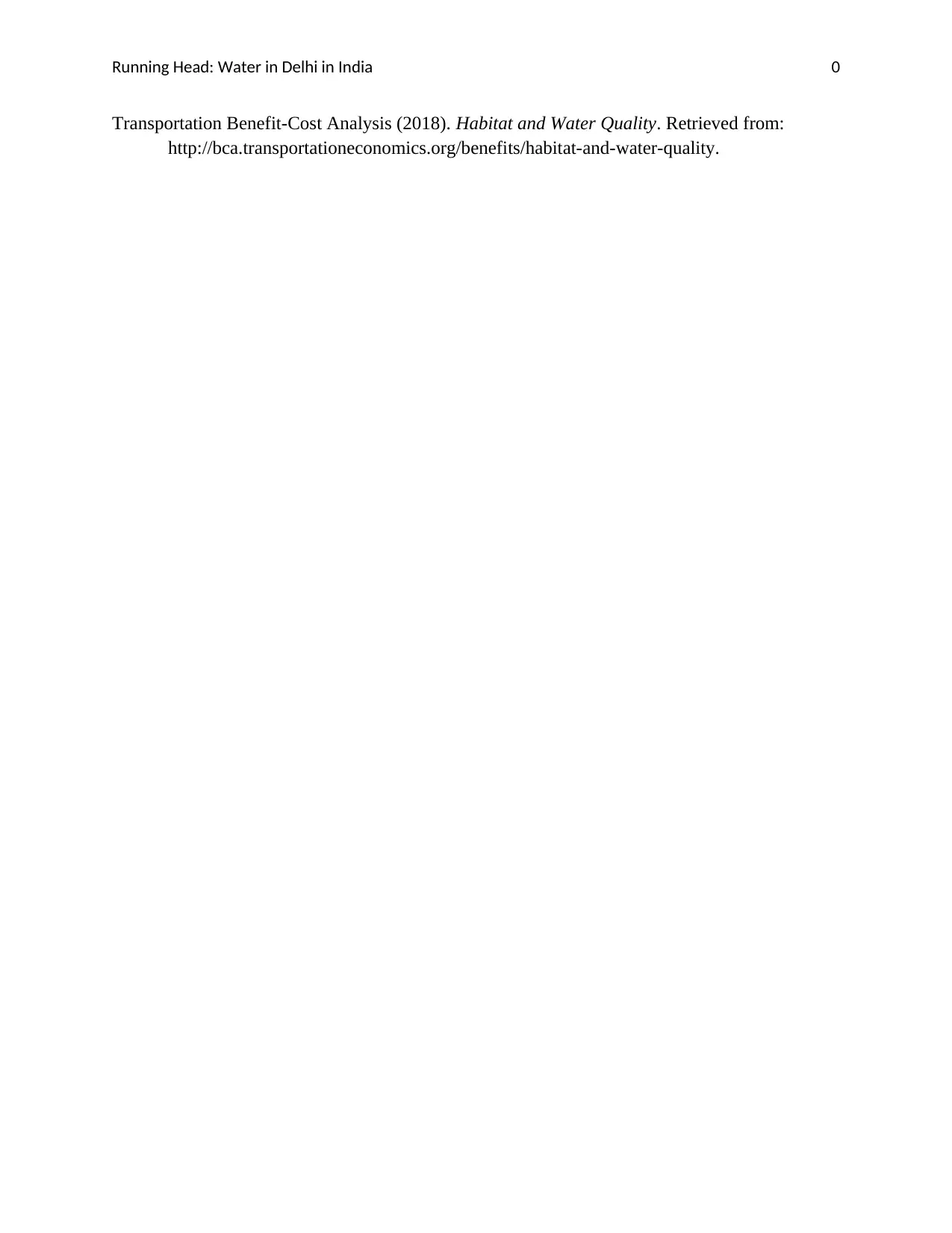
Running Head: Water in Delhi in India 0
Transportation Benefit-Cost Analysis (2018). Habitat and Water Quality. Retrieved from:
http://bca.transportationeconomics.org/benefits/habitat-and-water-quality.
Transportation Benefit-Cost Analysis (2018). Habitat and Water Quality. Retrieved from:
http://bca.transportationeconomics.org/benefits/habitat-and-water-quality.
1 out of 9
Related Documents
Your All-in-One AI-Powered Toolkit for Academic Success.
+13062052269
info@desklib.com
Available 24*7 on WhatsApp / Email
![[object Object]](/_next/static/media/star-bottom.7253800d.svg)
Unlock your academic potential
© 2024 | Zucol Services PVT LTD | All rights reserved.





